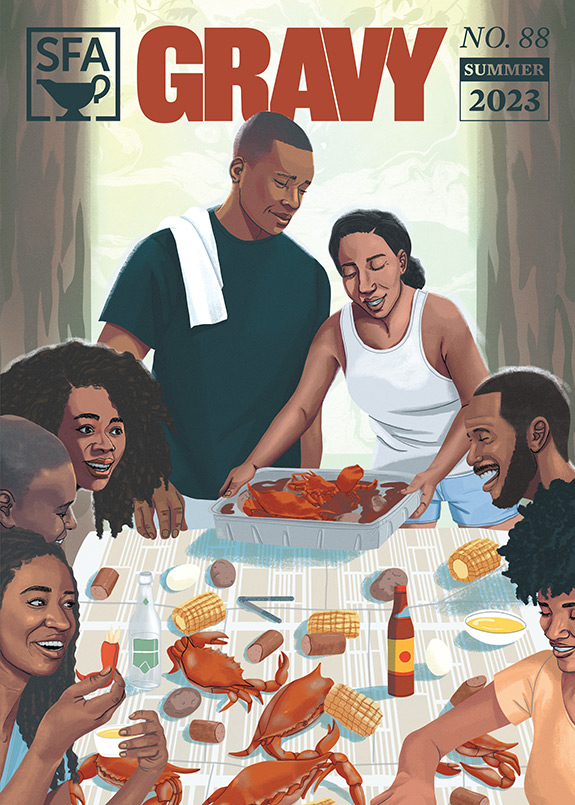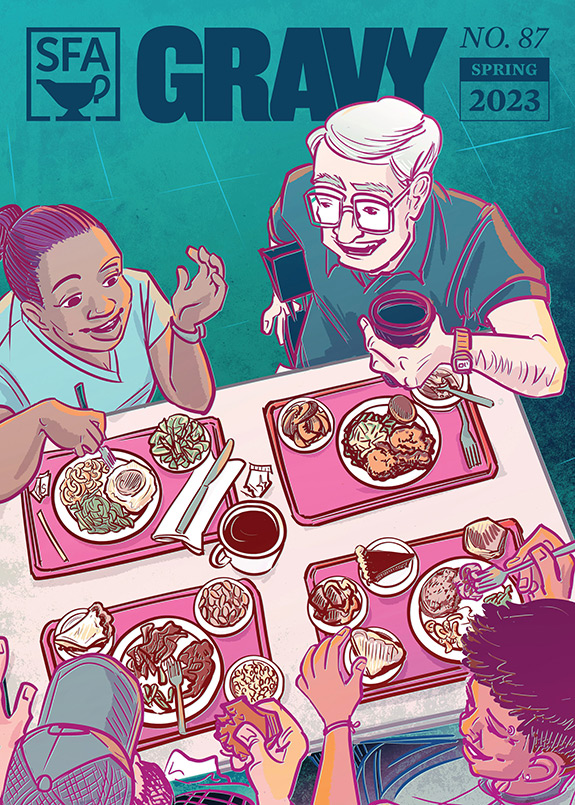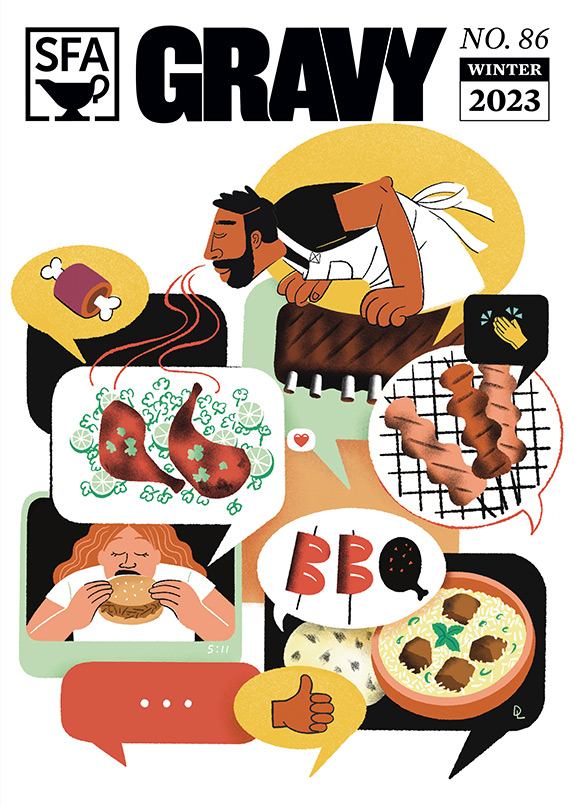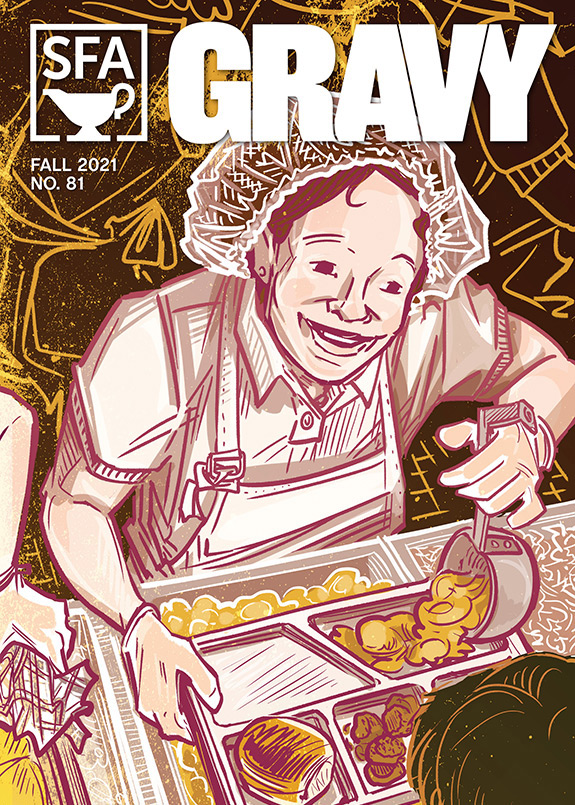This piece originally appeared in issue #51 of our Gravy quarterly. The author, Sheri Castle, is a native of Watauga County, North Carolina. Her dad still believes her move to Chapel Hill thirty-five years ago is a phase she will outgrow.
A Cake of Cornbread, a Jar of Chow-Chow, and Thou
An ode to store-bought pinto beans
by Sheri Castle
THIS IS A STORY ABOUT PINTO BEANS. But first it’s a story about my mountain people and one of our curious traditions.
The Appalachian Mountain South is to the rest of the South what bourbon is to whiskey: It is distinguishable from the rest, yet part of the whole. That includes our food, which is rooted in our geography. Like the rest of the rural South, mountain people traditionally ate off the land. Unlike the rest of the rural South, my people live up and back in one of the oldest mountain ranges on the planet, where the landscape and climate are quite different. On a map, we’re in the South. In practice, we claim our own place.
Mountain people were, and are, notably self-reliant, eating what they can forage, hunt, or raise for themselves. Farming in the Appalachian mountains is hard now and used to be nearly impossible. The land is combative. The growing season is fickle and fleeting. The ground can be as rocky as a dry creek bed.
Old timers quip that the easiest way to plant crops in the mountains is to load a shotgun with seed, stand on the porch, and blast it into the hillside. To survive the harsh and threatening winters, people preserve what they can’t eat immediately. In short, they grow it fast, and make it last.
Which brings us to beans. Starting with the Native Americans, every generation that has cultivated mountain land has known that certain types of beans flourish there. The Appalachian mountains were once home to dozens of varieties of nutrient-packed beans, including many that seed savers now categorize as heirlooms. When dried, these beans are excellent keepers.
Pinto beans, better known as soup beans, have been essential to the mountain larder since the early twentieth century. Yet Appalachian people didn’t grow their own. No matter how poor, they bought or traded for them.
This makes no sense. Why would people who produced nearly every speck of their own food buy dried pintos that had been grown up in Michigan? Not only buy them, but come to rely on them?
The handful of books and articles written about the foodways of the Southern Appalachians make little to no mention of this, so I started to ask around. I talked with people who know and love mountain food. They cogitated a long while, and finally threw up their hands, shook their heads, and replied, “That’s a good question.”
I finally sought the wisdom of Bill Best of Berea, Kentucky. A farmer and seed saver, Bill Best knows beans, especially mountain beans. Bill ventured that pinto beans were too inexpensive to warrant growing them. “Too cheap to bother,” he said.
Too cheap to bother. This from a people who use the phrase “ain’t worth a hill of beans” to describe things of very little value.
It probably happened like this: During the Depression, struggling mountain families realized that it cost less to buy dried pinto beans to eat than it cost to buy beans to grow. Mountain people couldn’t afford to grow pintos—and they couldn’t afford to do without them.
Dried pinto beans were about the cheapest protein available. A pot of beans remains astonishingly inexpensive. In 2014, a one-pound bag of dried pinto beans costs less than two dollars.
If mountain people once ate pintos because they had to, we now eat them because we want to. Those of us raised on soup beans never seem to lose our taste for them. A pot of beans is reassuringly familiar. We can rely on their tender creaminess; the traces of smoky pork, like the lingering scent of last night’s campfire; and the promise of sopping.
I once heard the musician Doc Watson, who lived his whole life in Deep Gap, North Carolina, wax poetic about his love for soup beans and cornbread. He said that he could never get his fill. “If I ate twice what there was, it would’ve been half what I wanted.”
Amen.
Watauga Soup Beans
Makes about 6 cups of cooked beans
1 pound dried pinto beans
Water
2 to 3 teaspoons salt, plus more to taste
Seasoning meat: a piece of side meat, 3 slices smoky bacon, or 2 tablespoons bacon grease
Aromatics: 2 crushed garlic cloves, 1 small halved onion, 1 to 2 fresh hot peppers, or a big pinch of cayenne pepper (optional)
POUR BEANS INTO A COLANDER and rinse under cool running water. Pick through and discard any shriveled or unappealing beans. Pour into a large bowl and cover with a couple of inches of cold water. Skim off any chaff. Let soak several hours or overnight.
By the next day, the beans will have absorbed much of the water and nearly doubled in size. Drain beans and rinse gently.
Transfer beans to a large, heavy pot. Cover with fresh water to a depth of 2 inches. Add seasoning meat and aromatics, if using. Bring to a boil over high heat, then reduce heat to a very gentle simmer. If you want the beans to be firm when done, leave the pot uncovered. If you want the beans to be creamy, partially cover the pot.
Check on beans once in a while to give them a little stir and to make sure they stay submerged in the cooking liquid. If the top has gone dry, add hot water to cover.
Check beans for doneness after 45 minutes. When the beans are barely tender, stir in the salt and continue to simmer until done, 15 to 45 minutes more. Taste for seasonings. If they are not salty enough, remove the pot from the heat and add more salt, to taste. The beans will continue to absorb salt as they cool.
Most bean eaters spoon on something bright and pungent such as chow-chow, piccalilli, chili sauce, or home-canned tomatoes. Some bean eaters appreciate the crunch of chopped raw onion. Transfer cooled beans to an airtight container.
Store refrigerated for up to one week.
 A FEW NOTES ON COOKING SOUP BEANS
A FEW NOTES ON COOKING SOUP BEANS
SORT. Most pintos these days are pretty clean, but because they are picked by machine, they harbor small pebbles and sticks. It pays to look through them carefully and rinse them thrice. As a boy, Bill Best lived in such fear of breaking a tooth on an errant rock in a bowl of soup beans that he always mashed each bite with his fork before eating it.
SEASON. Like so many things, beans need fat and salt. The fat can come from olive oil, but pintos prefer pork—a chunk of side meat, a couple of slices of smoky bacon, or a spoonful of bacon grease. People actually argue over when and how to salt dried beans, swearing that ill-timed seasoning makes the beans tough.
EAT. The moniker “soup beans” gives another clue to their charms. The beans and their seasoning make a delicious, satisfying potlikker. Cornbread is a requirement.
REHEAT. Pinto beans’ tolerance for reheating is part of their appeal. When reheated multiple times, they thicken and soften into something close to porridge. Cooked beans never look all that good in the first place, so declining appearance is not an inhibiting factor.
***
Sheri Castle is the author of The New Southern Garden Cookbook.









